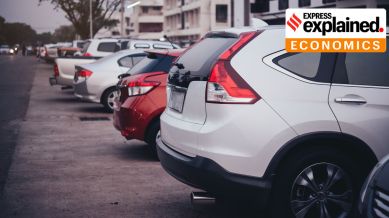This mixed bag was despite the fresh Goods and Services Tax (GST) overhaul kicking in last month, albeit towards the fag end, which made most cars generally cheaper than before. On top of that, the upcoming festive season too was expected to give further impetus to car sales. Curiously then, these factors combined are yet to give a boost to the industry, which has been sluggish over consumption and affordability challenges.
How carmakers performed
Maruti Suzuki maintained its top spot in the market, and saw domestic vehicle sales of 1,47,461 units in September 2025 compared to 1,56,999 units in September 2024. A key reason behind the slump is the sharp decline in the company’s utility vehicle (UV) sales, an area where it has faced increasing competition from the likes of Tata and Mahindra. Maruti’s UV sales, which includes models like the Brezza, Ertiga, Fronx, Grand Vitara, Invicto, Jimny, and XL6, saw sales decline to 48,695 units last month compared to 61,549 units same time last year. However, it marked a significant jump in export numbers, as the company exported 42,204 units in September 2025 compared to 27,728 units in September 2025.
Tata Motors sold the second highest number of cars in the country and recorded domestic sales of 59,667 units, up 45.3% YoY. The company also recorded its best ever month for electric vehicle (EV) sales, dispatching 9,191 units – a staggering 96% year-on-year surge.
Hyundai reported domestic wholesale sales of 51,547 units in September 2025. This was a marginal 0.9% increase over the 51,101 units sold in September 2024, although a growth of 17% from August’s 44,001 units, suggesting that the festive season demand along with the GST benefits might be beginning to materialise. The company also exported 18,800 units compared to 13,100 last year.
Hyundai’s sister company Kia though saw a decline in sales year-on-year, registering domestic sales of 22,700 in September 2025 compared to 23,523 units in September 2024.
Mahindra and Mahindra sold 56,233 vehicles in the domestic market, a growth of 10% and overall 58,714 vehicles, including exports.
Story continues below this ad
It is worth noting that the full effect of GST 2.0 may not yet have translated on the ground as the changes went into effect only on September 22. The tax relaxation could keep pushing more people to buy cars in the coming months.
Cars under the new GST
Under the next-generation reforms for GST, small cars with engine capacity not exceeding 1200 cc (petrol) and 1500 cc (diesel) and with length not over 4 metre will now be in the 18 per cent slab against 28 per cent plus cess levy earlier. Bigger cars will be taxed at 40 per cent (as against 28 per cent), with additional compensation cess of 17-22 per cent, taking the total tax to 50 per cent in some cases. All automotive parts will now be taxed at 18 per cent.
Pent up demand
The Indian Express had reported that leading up to September 22, showrooms had cut a deserted look as they anticipated deep discounts after the tax rate reduction, but were in for some disappointment as the transitional issues for dealers resulted in hurdles in the full pass through of the benefits.
Besides, a car dealer had said at the time that while people from the Muslim and Sikh communities were buying some cars, many Hindus were not because of Shraadh.
Story continues below this ad
While the GST overhaul reduced the rates on several cars and also did away with the compensation cess, dealers who had requisitioned the cars from manufacturers at the older rates have paid GST and cess on it. Those cars, which dealers had stocked up due to the incoming festive season, were proving difficult to sell, as customers were unwilling to buy cars at the older rate.
As a result, dealers were having to offer a discount on those cars out of their own pockets, with estimates suggesting that they could be staring at losses of Rs 2,500 crore, eroding their working capital. They are unsure whether there will be some relief in terms of refunds, and where it might come from.
Could small car sales be revived?
According to industry data, sales performance of entry-level cars priced below Rs 5 lakh — a crucial indicator of demand in the economy given that this segment largely attracts first-time buyers — is dire. This segment used to account for nearly a million units a decade ago, with 9,34,538 in FY16. It has since declined to just 25,402 units in FY25. The Maruti Suzuki Alto, for instance, sold more than 18,700 units in June 2019, and was the best-selling then. In June 2025, the Alto and S-Presso combined sold a little over 6,000 units.
In April-June 2025, passenger vehicle sales declined 1.4 per cent over the same quarter last year, and passenger car sales declined by more than 11 per cent in the same period.
Story continues below this ad
According to data collected by the NGO People Research on India’s Consumer Economy, which some carmakers refer to internally, car penetration in Indian households that have a yearly income of less than Rs 4 lakh reduced to 1.4 per cent in FY20, from 1.9 per cent in FY16.
Car penetration in households that earn between Rs 4 lakh to Rs 7 lakh annually also reduced to 8.3 per cent from 12.1 per cent in the same time period.
Families with incomes of less than Rs 4 lakh and between Rs 4 lakh and Rs 7 lakh are said to make up for around 80 per cent of all Indian households. Though FY20 was the latest data available with a carmaker, they said the trend has not changed in the subsequent years.
